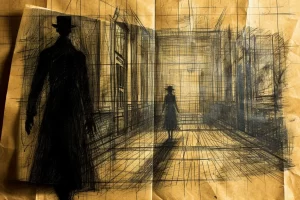The St. Louis Cathedral & the Haunted Alleys

The St. Louis Cathedral is the oldest continually operating cathedral in America. Three different Catholic churches have stood at the current site of the St. Louis, the first being built in 1718. But it wasn’t until 1793 that the church was raised to the status of cathedral by the Diocese of New Orleans. The cathedral is located in the French Quarter in front of Jackson Square, and is flanked on both sides by the historic Cabildo and Presbytère buildings. The cathedral was home to two of the most respected religious figures in New Orleans during the 18th and 19th centuries; Père Antoine and Père Dagobert. Both served as leading authorities in the city’s catholic community and in New Orleans overall. Père Antoine was revered for dedicating his time and effort towards helping the prisoners and enslaved people of the city, along with Marie Leveau, who he baptized. Dagobert was known for his popularity, often seen socializing with the city’s populace and breaking with the traditions of the Catholic church. The ghosts of both men have been seen in the Saint Louis Cathedral and the surrounding vicinity, and are commonly seen haunting the alleyways on either side of the cathedral. The Père Antoine Alley was named after the famed priest in 1924, as his spirit was, and still is, seen walking down the alley singing church hymns in the early mornings. Pirate Alley is named for legendary pirate Jean Lafitte, as his favorite bar, the Absinthe House, is right around the corner. It was rumored that pirates would sell their bootlegged wares along the alley fence at night. The ghosts of Jean Lafitte and Père Dagobert have both been seen walking around Pirates Alley.
History of the St. Louis Cathedral
The first church at the site of the current Saint Louis Cathedral was built in 1718. The church was dedicated to King Louis IX of France, also known as Saint Louis, having been the only french king to be made a saint. Interestingly enough, the city of New Orleans was founded that same year. Adrien de Pauger, a French engineer, chose the site for the church to be built on. He died before construction was finished, and was buried on the church grounds. The church stood for 70 years, before the Great Fire of 1788 tore through New Orleans, destroying much of the city’s infrastructure, including the church.
The fire started in the home of Army Treasurer Don Vicente Jose Nuñez, who lived right next to Jackson Square. Most of the buildings in the city were made with timber, making for an easy kindle for the fire. The massive inferno was further spread by heavy winds. And because it was Good Friday, the priests didn’t allow for the church bells to be rung as a warning, which led to more damage being done. Père Antonio was the church priest at the time, and some blamed the destruction of the city on him due to his refusal to ring the church bells.
Almost all of the major buildings in the area were destroyed, including the Church of Saint Louis.
The second church was rebuilt on the same site in 1794. One year earlier, while being rebuilt, it was raised to the status of cathedral by the Diocese of New Orleans. The architects added a central spire and clock bell in 1815 to commemorate the victory of the Battle of New Orleans. During these years, people of all social classes prayed and were baptized at the cathedral. This was mainly the work of Père Antoine, who placed a heavy emphasis on helping the lower classes and slaves in New Orleans.
In 1850, the church got a major uplift, with most of the Spanish architecture being demolished and rebuilt. The church got a new central spire, and was enlarged and expanded. This is the third and current iteration of the church.
The St. Louis Cathedral has survived numerous disasters. The building was bombed in 1909. Luckily, no one was present. While the culprits were never found, many blamed Italian immigrants or radical anarchists for the bombings. Just a few years later, a major Category 3 hurricane hit the city, overshadowing the bombing and causing major damage to the cathedral. In 2005, Hurricane Katrina devastated the city, again damaging the cathedral and tearing a hole in the roof.
Pope Paul the VI visited the cathedral in 1964 and declared the St. Louis Cathedral a minor basilica. Still, the people of New Orleans call it a cathedral for the sake of consistency. Pope John Paul II visited the cathedral in 1987.
Architecture and Alleyways of the St. Louis Cathedral
The architecture of the St. Louis Cathedral seems to stand in perfect symmetry with its surroundings. The cathedral has two spires on either side, with a central spire and clock tower. On both sides of the cathedral sit the Cabildo and the Presbytère. The two buildings are almost identical in appearance, creating a symmetry with the church. A statue of Andrew Jackson also sits directly in front of the church in Jackson Square.
Between the St. Louis Cathedral and the Cabildo is Pirates Alley, so called for Jean Lafitte, who was known to hang out there. They say that pirates used to sell their bootlegged wares on the fence of the alleyway. Père Antoine Alley sits between the cathedral and the Presbytère. It was formerly called Cloister’s Alley, until the ghost of Père Antoine was spotted in the alley.
Père Dagobert
Dagobert de Longoury was originally from Quebec, but moved to New Orleans to become part of the Catholic Church. He became the priest of the St. Louis Cathedral in 1745, and was soon appointed as vicar general of the diocese. He was praised for his kindness and dedication to the poor of New Orleans. He ran the Charity Hospital for 8 years in the 1750s. Père Dagobert spent much of his time fraternizing with the average people of New Orleans, being seen at weddings, births, and funerals. He was also kind of a foodie who hung out at taverns and bars. He was looked down upon by the authorities of the Catholic Church for breaking many of their traditions, like being too lax with Catholic rituals and wearing non-traditional clothing like tricorn hats. Both historians and the Catholic Church have greatly overlooked Père Dagobert’s contributions to this city of New Orleans.
Père Antoine
Antonio de Sedella, better known as Père Antoine, was a Spanish friar who served as the head Catholic priest for the city of New Orleans from his arrival in 1774 to his death in 1829. He was well known for his dedication to the city’s underclasses, and worked tirelessly to bring religion to the poor, prisoners, and slaves. He baptized the famous Marie Leveau when she was a child. Later, as Marie got older, the two worked to bring freedom to slaves and people of color in the city. He was both hated and loved by the people of New Orleans, though most Catholics were fond of Père Antoine. Both the garden behind the cathedral and the northeast alley are named after him. Père Antoine was appointed as the church’s Rector in 1793, when the church was raised to a cathedral, and served his post until his death. The entire city mourned the death of Père Antoine, and most businesses closed early the day of his death to pay their respects.
The Ghosts of the St. Louis Cathedral
Père Antoine is the most commonly spotted ghost in St. Louis Cathedral. He’s easily recognizable; there’s a large portrait of him in the church. He’s usually seen on the balcony or the altar, especially near the holidays. Members of the Catholic Church in New Orleans say that his apparition appears on the altar during the Midnight Mass holding a candle. Père Antoine’s spirit is most commonly seen in the alleyway that bears his name. He appears early in the morning, humming church songs under his breath. He’s been seen in the alley for almost 100 years, first being sighted in 1924. Witnesses say they’ve seen him in other parts of the city as well, like near the St. Louis Cemetery or around the French Quarter at night.
Père Dagobert is a common sight in the cathedral as well. They say he can be heard singing the hymn Kylie on rainy mornings. He tends to walk out of the St. Louis Cathedral and stroll down Pirates Alley, humming the entire way.
When Spain took over the city in 1768, a group of French Creoles ousted the new Spanish governor. Spain didn’t appreciate the revolt, and sent their soldiers to crush the revolt. Five surviving Creole ringleaders were rounded up and shot. The Spanish ordered the bodies not being buried. Dagobert and his men went to retrieve the bodies under the nose of the Spaniards. Dagobert gave them a proper burial and the church grounds. They say that Père Dagobert hangs around to keep watch over the rebels.
The ghost of the pirate Jean Lafitte has been seen walking through Pirates Alley, though some doubt that it’s actually Lafitte. Locals say that it’s another pirate by the name of Reginald Hicks. Hicks fell in love with a beautiful Creole woman just a few months before the War of 1812. He rushed to get married after finding out that his lover was pregnant with his child, as he didn’t want his kid to be illegitimate. The only priest that would marry them was a German priest who was in the prison next to the St. Louis Cathedral. The priest came to the fence at Pirates Alley and married Hicks and his lover. Hicks later died in the war, and it’s said that his ghost haunts the alleyway where he and his wife tied the knot.
The ghost of Delphine LaLaurie, of the LaLaurie Mansion, has been spotted walking the aisles of the church. She was known to go to mass and worship at the St. Louis Cathedral. It seems that her spirit still comes to pray at the cathedral.
Learn more about the haunted history of New Orleans!
New Orleans is an enchanted city, and by enchanted, I mean haunted. Grab a drink at the Old Absinthe House, and see the ghosts of Jean Lafitte and Andrew Jackson. Spend a night at the Hotel Monteleone, but watch out for the 13th…I mean…14th floor! If you get too frightened, maybe the friendly ghosts of the Hermann Grima House will make your day. Before you take a trip to the Big Easy, read about the top ten most haunted spots in New Orleans!
